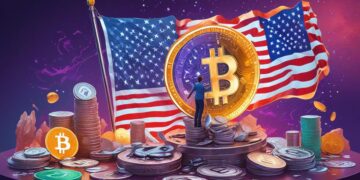The evolution of the NFT market in the United States and its challenges

Understanding the NFT Landscape
The emergence of non-fungible tokens (NFTs) has created a significant shift in the way we perceive ownership and authenticity in the digital realm, particularly in the United States. By utilizing blockchain technology, NFTs offer a unique solution to issues of replication and copyright in digital assets. They have opened new avenues in various sectors, garnering a diverse audience, from artists and musicians to gamers and brands.
Digital Art and Collectibles serve as one of the most prominent applications of NFTs. Artists have begun to leverage this technology to transform their creative works into unique digital assets. For instance, Beeple, a digital artist, made headlines when his NFT artwork sold for an astonishing $69 million at a Christie’s auction. This landmark sale not only illustrated the enormous potential of NFTs for artists but also challenged traditional perceptions of art value. Collectors can now buy, sell, and trade unique items in a way that was not possible before, fostering a new relationship between creators and their audiences.
Another exciting frontier lies within Gaming Integrations. Game developers are increasingly incorporating NFTs into their platforms, allowing players to own in-game assets, such as skins, weapons, or even virtual real estate. Games like Axie Infinity and Decentraland enable players to not only engage with their favorite virtual worlds but also to trade their assets on secondary markets. The emotional investment in these items fosters a deeper connection between gamers and the platforms they enjoy, ultimately creating a more immersive experience.
Furthermore, Brand Collaborations have surged, with major companies like Adidas, Nike, and Coca-Cola venturing into the NFT space. These brands are releasing exclusive merchandise, creating limited-edition products that enhance brand loyalty while offering customers a chance to own a piece of digital history. For example, NBA Top Shot allows fans to buy and trade officially licensed NBA collectible highlights, giving them a unique digital experience that fosters fan engagement.
Despite the euphoria surrounding NFTs, the market faces Regulatory Uncertainty. The absence of clear guidelines leaves many investors skeptical and hesitant. The U.S. government is still in the process of determining how to classify and regulate NFTs, which can impact their growth and acceptance. Additionally, the Market Volatility associated with NFTs poses challenges. The prices of many NFTs can fluctuate significantly, making it difficult for investors to make informed decisions regarding long-term investments.
Last but certainly not least, Sustainability Concerns regarding the environmental impact of blockchain technologies used to mint NFTs have sparked debates. Many blockchain networks utilize proof-of-work systems, which require significant energy consumption. Artists and collectors are starting to seek more sustainable platforms or reconsider their footprint in this evolving landscape.
To navigate this hybrid environment of innovation and challenge, it is crucial for individuals and businesses to stay informed. Engaging with the developments and understanding the implications of NFTs may provide opportunities that could reshape industries as we know them.
CHECK OUT: Click here to explore more
Transformative Forces Driving the NFT Market
The NFT market in the United States has witnessed a remarkable evolution, driven by a convergence of technological advancements and cultural shifts. From the explosive rise of digital art to the integration of NFTs in traditional retail, the landscape is changing rapidly. Understanding the factors that have propelled this transformation is essential for grasping the potential and challenges that lie ahead.
Technological Advances have played a pivotal role in the growth of the NFT market. The advent of blockchain technology has provided the foundation for creating, buying, and selling digital assets securely. Ethereum, the leading blockchain for NFTs, has enabled creators to mint unique tokens that can be traced back to their origin, providing proof of authenticity and ownership. As more platforms emerge to support NFT transactions, user-friendly interfaces have made it easier for a wider audience to participate in this new digital economy.
The traction gained by Social Media Influence cannot be overlooked. Platforms like Twitter and Discord have fostered vibrant communities where artists, collectors, and enthusiasts can connect and share ideas. The viral nature of social media has allowed NFT projects to gain attention rapidly, with influencers and celebrities entering the fray. Whether it’s Grimes releasing exclusive music NFTs or Gary Vaynerchuk promoting his NFT initiatives, these endorsements help to legitimize and popularize the market. As engagement grows, so does the interest from both local and international investors.
Moreover, the intersection of Culture and Creativity has ignited a buzz around NFTs. The ongoing conversation around digital ownership aligns with the ideals of a generation increasingly denoting their identity through digital expressions. Artists, musicians, and creators find themselves at the forefront of a new movement, leveraging NFTs to bypass traditional gatekeepers. This shift not only democratizes access to art but also empowers creators financially, allowing them to retain greater control over their work.
However, as the market matures, it faces a myriad of challenges that threaten its longevity and sustainability:
- Regulatory Hurdles: The lack of a clear legal framework for NFTs poses considerable risks. Questions about intellectual property rights, securities laws, and taxation remain unresolved, complicating the landscape for creators and investors alike.
- Market Saturation: With the influx of NFTs, the market risks becoming saturated with products, making it challenging for creators to stand out. Additionally, the oversupply may lead to significant price drops, affecting the perceived value of digital assets.
- Technical Exploits: The security of NFTs is paramount, yet the market has witnessed vulnerabilities, including hacks and scams. As stories of theft and fraud surface, trust in the ecosystem may wane, deterring potential participants.
- Environmental Impact: Criticism regarding the energy consumption associated with NFT minting continues to grow. Striking a balance between innovation and sustainability is crucial for the future acceptance of NFTs.
As we navigate this complex labyrinth of opportunities and obstacles, it becomes more imperative for those involved in the NFT market to be informed and adaptable. The evolving narrative of NFTs in the United States highlights not only the potential for transformational change but also the lessons we must embrace as we embark on this exciting journey.
SEE ALSO: Click here to read another article
The Intersection of Innovation and Responsibility
As the NFT market continues its rapid expansion within the United States, the dialogue surrounding responsibility grows increasingly vital. It’s not enough to merely celebrate the creativity and ingenuity that NFTs enable; we must also consider the ethical and practical implications of these digital assets. For creators, investors, and collectors, building a sustainable and equitable ecosystem is paramount.
One of the most pressing issues is related to Copyright and Intellectual Property. As digital ownership becomes easier to assert, the complexities of creative rights become more convoluted. Many artists find themselves navigating a precarious landscape where unauthorized reproductions of their work can flourish without consent. Additionally, platforms that facilitate NFT issuance must grapple with determining ownership, authenticity, and rights prior to allowing users to mint NFTs. A stronger legal framework could clarify these issues, offering guidance to artists and mitigating misunderstandings or potential exploitation.
The NFT space also grapples with the Question of Authenticity. Although blockchain technology provides a transparent ledger, verifying the actual creator of a digital asset can still be problematic. Counterfeit NFTs and “wash trading,” where sellers artificially inflate the value of their NFTs, threaten to undermine the trust and credibility that are essential to the market. As buyers become more discerning, platforms need to implement verification systems that authenticate creators and their works, ensuring that buyers feel confident in their investments.
Furthermore, the NFT market faces the challenge of Accessibility and Inclusivity. While the technology driving NFTs has democratized art ownership, barriers remain for marginalized creators and collectors. High transaction fees and unequally distributed technological resources can prevent many from participating. Initiatives aimed at reducing fees and providing educational resources could empower a broader range of creators, enriching the NFT landscape with diverse voices.
The financial implications of the NFT craze also warrant scrutiny. The potential for Market Volatility poses a significant risk for investors. The dramatic rises and falls in the values of NFTs can result in considerable losses for those who jump into the market without adequate knowledge or caution. Investors need to approach NFTs with the same level of diligence they would apply to traditional assets. Risk management strategies and more comprehensive educational resources about NFT investments can help temper this volatility.
Lastly, the Environmental Concerns surrounding NFTs must not be overlooked. As previously mentioned, the energy consumption associated with blockchain technology, particularly Ethereum, has led to significant criticism. The push for more energy-efficient alternatives is gaining momentum. The Ethereum network’s transition to proof-of-stake is a promising direction, yet the industry must continue to seek innovative solutions that balance technological advancement with ecological responsibility. Eco-friendly platforms can attract a more conscientious consumer base, aligning with the values of a society that increasingly prioritizes sustainability.
By acknowledging and addressing these challenges, stakeholders in the NFT market can not only foster a more vibrant and equitable industry but also pave the way for its long-term viability. The evolution of this exciting digital frontier is still in its infancy, spurred on by a rich mix of creativity, technology, and community engagement. Yet, it also stands as a mirror reflecting the responsibilities and dilemmas we face in shaping its future.
SEE ALSO: Click here to read another article
Charting a Course Through Uncharted Waters
As we look to the future of the NFT market in the United States, it is evident that our journey is just beginning. The dynamism of this market, coupled with the rapid technological advancements and creative exploration, presents a landscape ripe with potential. However, this potential brings with it a series of complicated challenges that demand our attention and action. From the obscured paths of copyright and intellectual property to the pressing need for transparency regarding authenticity, every facet of the NFT ecosystem requires a thoughtful and deliberate approach.
The call for inclusivity and accessibility resonates deeply, urging us to cultivate an environment that allows voices from all walks of life to flourish in the digital art space. It is crucial that we dismantle existing barriers, enabling a genuinely diverse artistic community that enriches the fabric of the NFT market. Investors, too, must exercise caution and equip themselves with knowledge to navigate the volatile financial waters of this emerging asset class.
Moreover, as we embrace this digital frontier, the environmental impact of blockchain technologies cannot be sidelined. The shift towards greener alternatives should move from being a mere aspiration to an industry standard. By integrating sustainability into the core mission of NFT platforms, we create a pathway that not only respects our planet but also aligns with the ethical values of an increasingly aware consumer base.
In recognizing and addressing these pivotal challenges, we have the opportunity to transform the NFT landscape into a thriving, fair, and responsible marketplace. Ultimately, it is the synergy of innovation, responsibility, and community engagement that will define the next chapter of the NFT evolution in the United States. As we continue to explore this vibrant frontier, let us strive for a future where creativity thrives, inclusivity prevails, and ethical practices guide our endeavors.

James Carter is a financial writer and consultant with expertise in economics, personal finance, and investment strategies. With years of experience helping individuals and businesses navigate complex financial decisions, James provides practical insights and analysis. His goal is to empower readers with the knowledge they need to achieve financial success.




